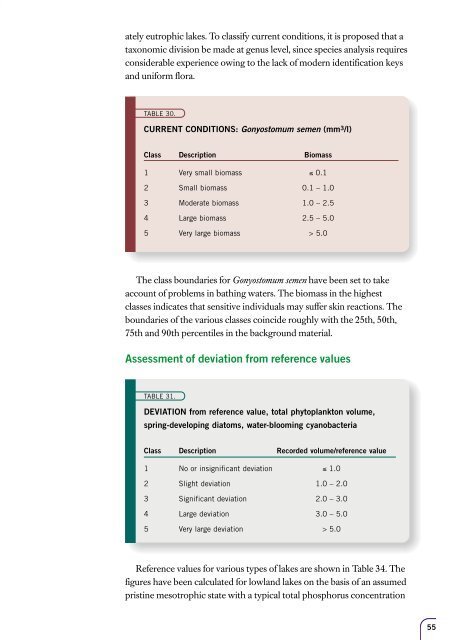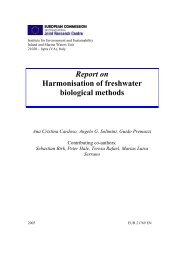Lakes and Watercourses
Lakes and Watercourses
Lakes and Watercourses
You also want an ePaper? Increase the reach of your titles
YUMPU automatically turns print PDFs into web optimized ePapers that Google loves.
ately eutrophic lakes. To classify current conditions, it is proposed that a<br />
taxonomic division be made at genus level, since species analysis requires<br />
considerable experience owing to the lack of modern identification keys<br />
<strong>and</strong> uniform flora.<br />
TABLE 30.<br />
CURRENT CONDITIONS: Gonyostomum semen (mm 3 /l)<br />
Class Description Biomass<br />
1 Very small biomass ≤ 0.1<br />
2 Small biomass 0.1 – 1.0<br />
3 Moderate biomass 1.0 – 2.5<br />
4 Large biomass 2.5 – 5.0<br />
5 Very large biomass > 5.0<br />
The class boundaries for Gonyostomum semen have been set to take<br />
account of problems in bathing waters. The biomass in the highest<br />
classes indicates that sensitive individuals may suffer skin reactions. The<br />
boundaries of the various classes coincide roughly with the 25th, 50th,<br />
75th <strong>and</strong> 90th percentiles in the background material.<br />
Assessment of deviation from reference values<br />
TABLE 31.<br />
DEVIATION from reference value, total phytoplankton volume,<br />
spring-developing diatoms, water-blooming cyanobacteria<br />
Class Description Recorded volume/reference value<br />
1 No or insignificant deviation ≤ 1.0<br />
2 Slight deviation 1.0 – 2.0<br />
3 Significant deviation 2.0 – 3.0<br />
4 Large deviation 3.0 – 5.0<br />
5 Very large deviation > 5.0<br />
Reference values for various types of lakes are shown in Table 34. The<br />
figures have been calculated for lowl<strong>and</strong> lakes on the basis of an assumed<br />
pristine mesotrophic state with a typical total phosphorus concentration<br />
55















![Accommodation booking form [PDF]](https://img.yumpu.com/39471785/1/184x260/accommodation-booking-form-pdf.jpg?quality=85)

